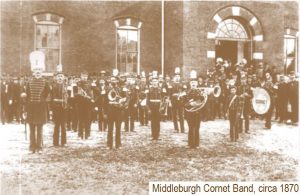Keyed Bugle
 This keyed bugle belonged to Philip Richtmyer, who played it in the Middleburgh Band in the mid-1800s.
This keyed bugle belonged to Philip Richtmyer, who played it in the Middleburgh Band in the mid-1800s.
This extremely rare instrument was made by Graves & Company in Winchester,. New Hampshire, probably in the 1840s. Made of copper, it features seven brass keys and is played with all the fingers of the right hand, plus the left thumb and forefinger.
It was donated to the museum in 1949 by William G. Richtmyer, complete with a unique ivory mouthpiece and felt-lined wooden case. The only repair necessary to make the instrument playable was gluing a new felt pad to one key, the temporary addition of a rubber band to compensate for a broken spring, and substitution of a metal mouthpiece.
Keyed horns were popular very briefly in the early 1800s, and began the movement toward brass bands. Brass horns are louder and less affected by temperature and moisture than stringed instruments or woodwinds, and were therefore preferred for outdoor performances.

Joseph Haliday of Dublin, Ireland patented the keyed, or Kent, bugle in 1810. The keys enabled the horn to play all the notes of the scale, plus most sharps and flats. Soon the Kent bugle was enlarged into a whole family of soprano, alto, tenor and bass horns, and the brass band was born. The tenor and bass bugles were known as ophicleides.
The development of piston and rotary valves in the 1840s marked the beginning of the end for keyed brasses, since valved horns produced a better, more even sound quality from note to note, and were somewhat easier to play. By the time of the American Civil War, only a few older or highly-skilled musicians continued to play keyed brasses, as in Philip Richtmyer’s case.
The bugle is currently on display in the Badgley Museum Annex at the Old Stone Fort Museum Complex.